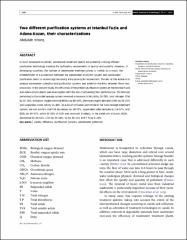| dc.contributor.author | Yinanç, Abdullah | |
| dc.date.accessioned | 2022-05-11T14:47:52Z | |
| dc.date.available | 2022-05-11T14:47:52Z | |
| dc.date.issued | 2017 | |
| dc.identifier.issn | 0273-1223 | |
| dc.identifier.issn | 1996-9732 | |
| dc.identifier.uri | https://doi.org/10.2166/wst.2017.137 | |
| dc.identifier.uri | https://hdl.handle.net/20.500.11776/10565 | |
| dc.description.abstract | In most developed countries, wastewater treatment plants are presently utilizing efficient purification technology meeting the sufficiency requirements of quality and quantity. However, in developing countries, the number of wastewater treatment plants is limited. As a result, the establishment of a connection between the wastewater collection system and wastewater purification plants is increasingly becoming a top priority for researchers. The aim of this article is to analyze wastewater collection and purification systems and establish the links between these two processes. In the present study, the efficiency of the present purification system at the Istanbul-Tuzla and Adana-Kozan plants was investigated with the aim of enhancing their performance. The findings pertaining to the model sewage system revealed a decrease in NH3-N by 20-70%, total nitrogen (T-N) by 25-75%, biological oxygen demand (BOD5) by 50-60%, chemical oxygen demand (COD) by 35-55% and suspended solids (SS) by 55-85%. As a result of studies performed in the Tuzla sewage treatment system, we can confirm that T-N decreased by 50-75%, suspended solid particles by 24-57%, and BOD5 by 34-57%, while 35-55% of COD was removed. Similarly, in the canal exit at K.zan, BOD5 decreased by 40-55%, COD by 30-50%, SS by 25-45% and T-N by 5-40%. | en_US |
| dc.language.iso | eng | en_US |
| dc.publisher | Iwa Publishing | en_US |
| dc.identifier.doi | 10.2166/wst.2017.137 | |
| dc.rights | info:eu-repo/semantics/openAccess | en_US |
| dc.subject | canals | en_US |
| dc.subject | efficiency | en_US |
| dc.subject | purification systems | en_US |
| dc.subject | wastewater collection | en_US |
| dc.subject | Waste-Water Treatment | en_US |
| dc.subject | Efficiency | en_US |
| dc.title | Two different purification systems at Istanbul-Tuzla and Adana-Kozan, their characterizations | en_US |
| dc.type | article | en_US |
| dc.relation.ispartof | Water Science and Technology | en_US |
| dc.department | Meslek Yüksekokulları, Teknik Bilimler Meslek Yüksekokulu, İnşaat Bölümü | en_US |
| dc.authorid | 0000-0002-8144-8266 | |
| dc.identifier.volume | 75 | en_US |
| dc.identifier.issue | 11 | en_US |
| dc.identifier.startpage | 2607 | en_US |
| dc.identifier.endpage | 2614 | en_US |
| dc.institutionauthor | Yinanç, Abdullah | |
| dc.relation.publicationcategory | Makale - Uluslararası Hakemli Dergi - Kurum Öğretim Elemanı | en_US |
| dc.authorscopusid | 57194470624 | |
| dc.authorwosid | YINANC, Abdullah/I-7843-2016 | |
| dc.identifier.wos | WOS:000403486600013 | en_US |
| dc.identifier.scopus | 2-s2.0-85021765192 | en_US |
| dc.identifier.pmid | 28617280 | en_US |



















